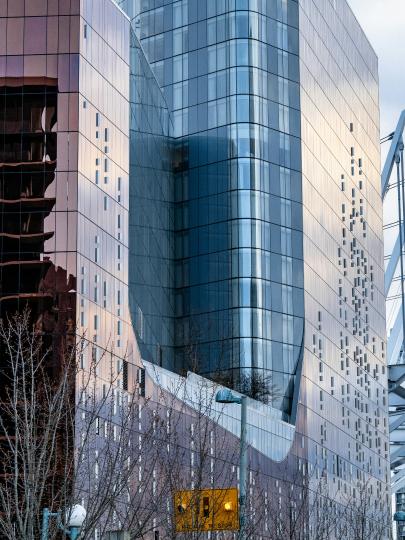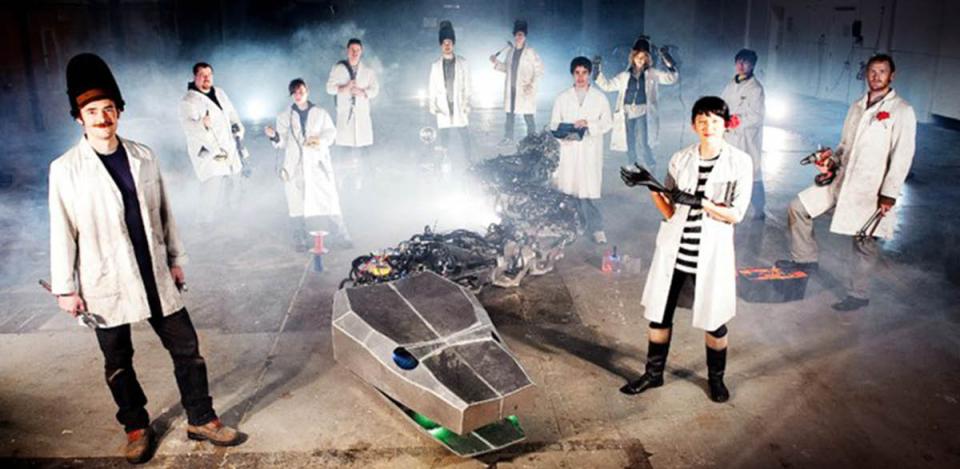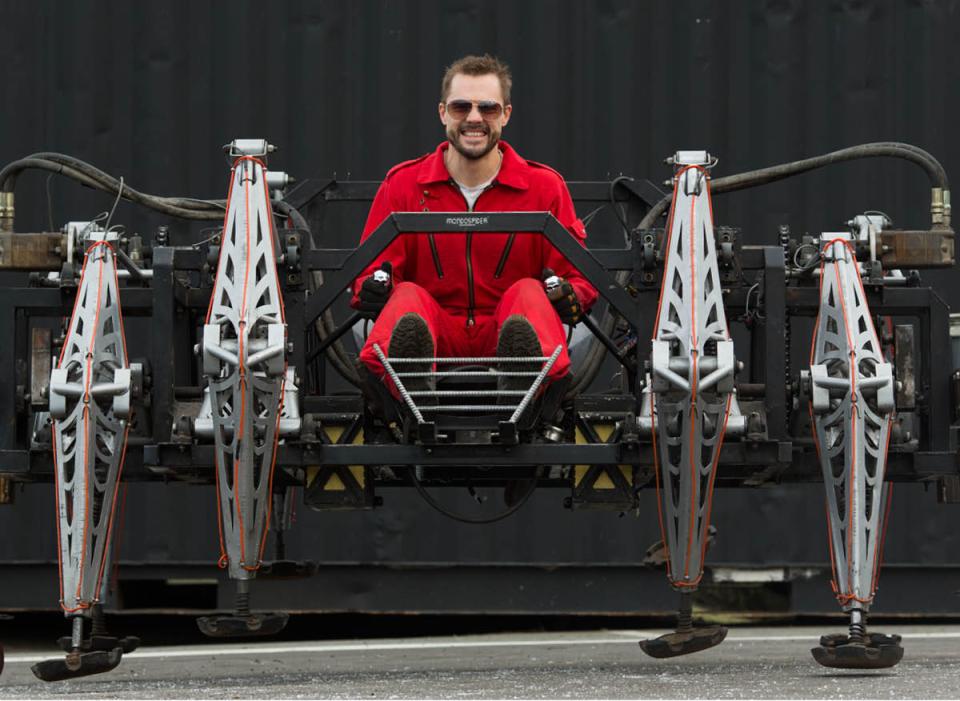Giant Spiders and Walking Machines
Imagine this: a three-ton steel exoskeleton crouching in the Nevada desert like a behemoth rabbit without a head. It rises and begins loping across the sand. With each stride, the creature covers four-and-a-half metres and gains speed until it is moving as fast as a man at full sprint.
Strapped inside the exoskeleton, dwarfed by his massive quadrupedal creation, is Jonathan Tippett, BASc’99. As he moves his arms, the creature’s two outside legs lunge forward. When he kicks his legs, the two inside legs move. As Tippett pushes his limbs with more force, the creature responds, magnifying each human motion into a wild, mechanical romping gait perfectly suited to the scale of the Black Rock Desert, a 2,600 square‑kilometre expanse. At least this is Tippett’s fantasy. He hopes to finish and unveil his creature – better described as a wearable walking machine called Prosthesis – at the Burning Man festival in Black Rock City in 2014.
So much of what makes art worth making is having somewhere to exhibit it.
Black Rock City is a horseshoe‑shaped city that springs up every August for just one week in the dry lake bed of the Black Rock Desert in northern Nevada, about 175 kilometres north of Reno. The temporary city – the fifth largest in Nevada for the week it exists – is home to the Burning Man festival, a wild, hallucinatory art and music bacchanalia dedicated to radical self‑expression as well as radical communal participation.
Burning Man is many things. It is a place that tests self‑sufficiency, requiring participants to provide for their own basic needs in a desert heat that routinely peaks at over 38°C, and clean up their camp a week later leaving no trace behind. It is a place for experimentation on a massive scale, with 50,000 people arriving each year (attendance was capped in 2011) with the mandate to shed conventions, participate, celebrate, and express themselves in any and every conceivable way. It is also an insanely large gallery space. The crescent of Black Rock City arcs around a 24 metre-tall wooden effigy known as “The Man,” which is set aflame as the culmination of the festival. Dotted around The Man and stretching beyond the city’s arc into the desert beyond are the sort of astounding art installations and interactive spectacles that could only be inspired by the creative spirit of Burning Man and the vastness of the playa. “So much of what makes art worth making is having somewhere to exhibit it,” Tippett explains. Intended to stand more than five metres tall, Prosthesis is certainly designed for big spaces.
Prosthesis is one several projects currently underway in the laboratory of eatART, a radical art collective based in Vancouver. The acronym stands for Energy Awareness Through ART, and their mandate is simple: to foster large-scale technically-sophisticated art that raises questions about the social and environmental impact of energy use. Yet eatART is anything but predictable. Take, for example, the mechanical love story at its origins: in 2007 the Mondo Spider, a 725-kilogram walking spider, and Daisy, a three-and-a-half ton solar power bicycle fell in love at Burning Man and begat eatART. In other words, Tippett, Charlie Brinson, Leigh Christie and Ryan Johnston (co-creators of Mondo Spider) met Rob Cunningham (caretaker of Daisy) through their shared love of mechanical art and Burning Man. But their sense of wild adventure had a purpose: they wanted to start a charitable organization that would promote energy awareness but would not necessarily demonstrate practical implementations of new technology or be conventional in its ways of reaching the public. “We wanted to capture audiences that would otherwise glaze over if you said ‘sustainability.’” Instead they would earn international attention through art – huge-scale, highly-engineered kinetic art.
Located on the Great Northern Way Campus, nestled between the Centre for Digital Media and the train tracks, the eatART lab is described by the artists as “an impossible dream factory,” and is filled with improbably large mechanical creations. To get into the lab, you have to squeeze by Mondo Spider, about the size of a small car, which lurks outside the main doors. In the back corner on a raised platform sits a section of Brinson’s latest project, Titanoboa, a 15-metre electro-mechanical reincarnation of a monstrous primordial snake that slithers with an eerie verisimilitude. (The snake was rendered extinct 60 million years ago by climate change.) In the middle of the space is the only modest-sized project in the lab, gBikes: bicycles retrofitted with hub motors and capable of generating enough electricity to power a laptop. The Alpha Leg, a prototype of one of Prosthesis’ four legs, dominates an entire side of the lab, and it is only two thirds of the planned size.
The artists who work in the lab are mostly engineers with the highly sophisticated technical knowledge required to design, model, and build massive robotics.
The artists who work in the lab are mostly engineers with the highly sophisticated technical knowledge required to design, model, and build massive robotics. Tippett graduated from UBC with a mechanical engineering degree in 1999. Brinson has a bachelor’s in engineering physics (2004) and a master’s in mechanical engineering (2006), both from UBC. For Tippett, large moving machinery lends itself to a richer discussion about energy use than, say, a laser lightshow. “Once you get into large, heavy things moving, you have the inevitable exchange of energy – kinetic energy, stored energy, electrical energy, hydraulic energy, pneumatic energy. With large things moving, you also have issues of efficiency, which you wouldn’t get with a lightshow. Lightshows are dynamic and engaging but they don’t have as many forms of energy to play with as physical systems.” Absurdly large moving parts catch the eye and easily spark conversation about energy awareness and our relationships with technology, and eatART members are involved in educational outreach and mentorship. In 2009, Tippett began sponsoring capstone programs with UBC’s mechanical engineering and engineering physics programs. Brinson also has teams of engineering students working on various aspects of Titanoboa. “Our involvement with students at UBC and SFU has become a hugely rewarding part of the projects,” he says. “Students get involved with all parts of the process. In fact a couple of the team’s core members came as students and then continued on.” Mondo Spider and Titanoboa also make regular appearances at festivals and science events geared towards getting kids excited about science and engineering.
But for all the technology and energy education involved, eatART has the aura of wild adventure, a whiff of Mad Hatter mechanical genius that even took the organisers of Burning Man by surprise when Mondo Spider first scuttled across the sand. Burning Man has long been a showcase for absurdly large-scale mobile art. But unlike most of the art cars that roam the playa, the spider is not simply art mounted on a pre-existing vehicle. The eight-legged electro-mechanical machine is its own creature. The organizers were unsure whether to categorize it as art installation or mutant vehicle – each gets a separate license to exist on the playa. “It was a real feather in our cap to confuse the organisers of Burning Man,” Tippett recalls. “It’s a pretty big achievement to bring something there that they haven’t seen before.”
Eight years on, no one has ever seen anything like Prosthesis before. Tippett’s first sketches date back to 2005. But then along came the spider (Tippett was “Team Leg” leader) and building the eatART Foundation. In 2008 he scaled back his work as a biomedical engineer designing vascular implants to act as Lab Chief for the organization. It was not until 2012 that he stepped down from this position to devote himself to Prosthesis.
The harder the pilot works – his movements will be somewhat like a gorilla’s lope – the faster Prosthesis moves.
What makes Prosthesis unique is not its vast size – although size is crucial to its essence – but how it moves. Prosthesis is not the sort of machine that a human manoeuvres remotely like a radio-controlled aircraft. It has no computerized control system, no remote, and no autonomy to move by itself, which is why Tippett calls Prosthesis the Anti-Robot. With the aim of reuniting humans with machines in the ancient quest of physical mastery and skill, Prosthesis only moves when a human climbs inside, straps himself into a five point harness, attaches hydraulic cylinders to his arms and legs, and begins “walking” four metres above ground. The harder the pilot works – his movements will be somewhat like a gorilla’s lope – the faster Prosthesis moves. Likewise, the exoskeleton relays positional and force feedback to the pilot so that he knows exactly how hard each foot hits the ground. But the engineering required to fine tune the suspension, hydraulics, and communication between man and machine are only half of the project. Tippett then has to fasten himself to three tons of steel and learn to walk, which even he admits will be terrifying. All four legs move independently, which means he must learn to keep the legs in sync and to keep the machine stable particularly over uneven ground, and since Prosthesis’ limbs will mostly be under or behind the pilot, he will be operating the machine mostly by feel alone.
To move a machine as if it were an extension of your own limbs will be a completely unprecedented experience and will require an extraordinary amount of coordination. There will be hundreds of training hours before Tippett and his machine are working together seamlessly, but when at last Prosthesis is finally let loose in the Black Rock Desert, “in its wild place,” that will be a moment of “such glory,” he says, “that I can’t even describe it. That will be my Holy Grail moment.”


































